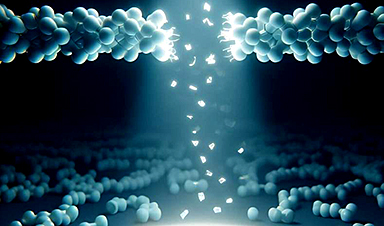What if recycling plastics were as simple as flicking a switch? At TU/e, Assistant Professor Fabian Eisenreich is making that vision a reality by using LED light to both create and break down a new class of high-performance plastics. This innovative material enables truly circular recycling, as this process can be repeated over and over again, without any loss in quality.
This research, published in the Rising Stars edition of Advanced Materials, marks a breakthrough in sustainable chemistry and could reshape how we treat plastic waste in the future.
“In fact, we are molecular designers,” is how Eisenreich describes himself and his fellow scientists from the Polymer Performance Materials research group. In their labs at the Department of Chemical Engineering and Chemistry, that is what the focus is on.
“Our line of research centers on ‘design for recycling.’ We create new polymers to enable innovative recycling strategies for plastics. At the same time, we use organic (bio-based) materials, avoid toxic substances, and minimize waste to keep the entire process as sustainable as possible.”
Quality of polymer chains deteriorates
These polymers are developed to enable chemical closed-loop recycling, the ultimate goal of the research group. “Plastics typically consist of moldable polymer chains. Due to the current way in which plastics are usually recycled—in a nutshell: heating, melting, and reshaping—the quality of those polymer chains deteriorates over time. So you can’t keep doing that indefinitely, which means that new plastic will eventually have to be made anyway.”
Chemical closed-loop recycling is therefore the ideal alternative, according to Eisenreich. “With the right chemical reaction, a polymer chain can be selectively broken down into its original building blocks. These can then be reused to make exactly the same polymer again, with identical properties and quality.” Achieving this requires polymers designed to undergo that precise reaction—hence the focus of the Polymer Performance Materials group’s research.
Selectively splitting a polymer with light
Within that context, Eisenreich specifies his own research on photochemical recycling, powered by LED light. “Making polymers by means of light is relatively simple. But breaking and making them again in the same way, aka recycling, is much more complicated and therefore a whole new line of research. The challenge lies in using light to selectively split stable chemical bonds within the polymer, so the original building blocks can be recovered.”
Recently, Eisenreich and Ahsen Sare Yalin, a third-year Ph.D. candidate in his group, became the first to successfully pull off this trick in his lab.
Reshape the way we deal with plastic waste
“We see it as a breakthrough in sustainable chemistry that can reshape the way we deal with plastic waste in the future,” says Eisenreich. “At the moment, our designer polymer is still a niche material and therefore not suitable for everyday plastic applications. Instead, it is aimed at specialized uses, for example, as a recyclable adhesive that binds strongly to glass and other plastics.”
Ultimately, further development should broaden the application possibilities. Moreover, Eisenreich sees plenty of potential in closed-loop recycling technology with light. “I also work on 3D printing recyclable polymers using light, which is a very interesting process. You start with a liquid material that takes on a solid form as soon as light falls on it. You can use this process to print complex 3D objects.”
His goal is to one day realize photochemical recycling of traditional plastics with only sunlight. “Then you don’t need any other energy source, how cool would that be?” Eisenreich’s chemical breakthrough is therefore not only shining new light on plastic recycling, but also on his entire field. “This is not just a new material. It’s a new way forward.”
More information: Ahsen Sare Yalin et al, A Light‐Driven Closed‐Loop Chemical Recycling System for Polypinacols, Advanced Materials (2025). DOI: 10.1002/adma.202506733
Journal information: Advanced Materials
Provided by Eindhoven University of Technology
News
Very low LDL-cholesterol correlates to fewer heart problems after stroke
Brigham and Women's Hospital's TIMI Study Group reports that in patients with prior ischemic stroke, very low achieved LDL-cholesterol correlated with fewer major adverse cardiovascular events and fewer recurrent strokes, without an apparent increase [...]
“Great Unified Microscope” Reveals Hidden Micro and Nano Worlds Inside Living Cells
University of Tokyo researchers have created a powerful new microscope that captures both forward- and back-scattered light at once, letting scientists see everything from large cell structures to tiny nanoscale particles in a single shot. Researchers [...]
Breakthrough Alzheimer’s Drug Has a Hidden Problem
Researchers in Japan found that although the Alzheimer’s drug lecanemab successfully removes amyloid plaques from the brain, it does not restore the brain’s waste-clearing system within the first few months of treatment. The study suggests that [...]
Concerning New Research Reveals Colon Cancer Is Skyrocketing in Adults Under 50
Colorectal cancer is striking younger adults at alarming rates, driven by lifestyle and genetic factors. Colorectal cancer (CRC) develops when abnormal cells grow uncontrollably in the colon or rectum, forming tumors that can eventually [...]
Scientists Discover a Natural, Non-Addictive Way To Block Pain That Could Replace Opioids
Scientists have discovered that the body can naturally dull pain through its own localized “benzodiazepine-like” peptides. A groundbreaking study led by a University of Leeds scientist has unveiled new insights into how the body manages pain, [...]
GLP-1 Drugs Like Ozempic Work, but New Research Reveals a Major Catch
Three new Cochrane reviews find evidence that GLP-1 drugs lead to clinically meaningful weight loss, though industry-funded studies raise concerns. Three new reviews from Cochrane have found that GLP-1 medications can lead to significant [...]
How a Palm-Sized Laser Could Change Medicine and Manufacturing
Researchers have developed an innovative and versatile system designed for a new generation of short-pulse lasers. Lasers that produce extremely short bursts of light are known for their remarkable precision, making them indispensable tools [...]
New nanoparticles stimulate the immune system to attack ovarian tumors
Cancer immunotherapy, which uses drugs that stimulate the body’s immune cells to attack tumors, is a promising approach to treating many types of cancer. However, it doesn’t work well for some tumors, including ovarian [...]
New Drug Kills Cancer 20,000x More Effectively With No Detectable Side Effects
By restructuring a common chemotherapy drug, scientists increased its potency by 20,000 times. In a significant step forward for cancer therapy, researchers at Northwestern University have redesigned the molecular structure of a well-known chemotherapy drug, greatly [...]
Lipid nanoparticles discovered that can deliver mRNA directly into heart muscle cells
Cardiovascular disease continues to be the leading cause of death worldwide. But advances in heart-failure therapeutics have stalled, largely due to the difficulty of delivering treatments at the cellular level. Now, a UC Berkeley-led [...]
The basic mechanisms of visual attention emerged over 500 million years ago, study suggests
The brain does not need its sophisticated cortex to interpret the visual world. A new study published in PLOS Biology demonstrates that a much older structure, the superior colliculus, contains the necessary circuitry to perform the [...]
AI Is Overheating. This New Technology Could Be the Fix
Engineers have developed a passive evaporative cooling membrane that dramatically improves heat removal for electronics and data centers Engineers at the University of California San Diego have created an innovative cooling system designed to greatly enhance [...]
New nanomedicine wipes out leukemia in animal study
In a promising advance for cancer treatment, Northwestern University scientists have re-engineered the molecular structure of a common chemotherapy drug, making it dramatically more soluble and effective and less toxic. In the new study, [...]
Mystery Solved: Scientists Find Cause for Unexplained, Deadly Diseases
A study reveals that a protein called RPA is essential for maintaining chromosome stability by stimulating telomerase. New findings from the University of Wisconsin-Madison suggest that problems with a key protein that helps preserve chromosome stability [...]
Nanotech Blocks Infection and Speed Up Chronic Wound Recovery
A new nanotech-based formulation using quercetin and omega-3 fatty acids shows promise in halting bacterial biofilms and boosting skin cell repair. Scientists have developed a nanotechnology-based treatment to fight bacterial biofilms in wound infections. The [...]
Researchers propose five key questions for effective adoption of AI in clinical practice
While Artificial Intelligence (AI) can be a powerful tool that physicians can use to help diagnose their patients and has great potential to improve accuracy, efficiency and patient safety, it has its drawbacks. It [...]





















